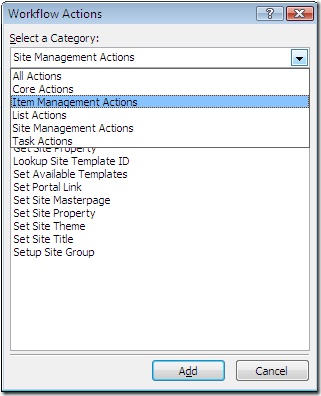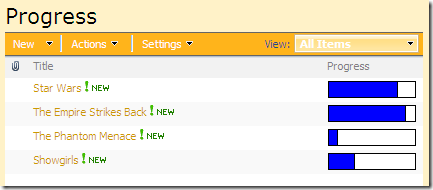SharePoint Wednesday CodePlex Roundup #2
Welcome back to what seems to be a successful launch of a new blog series. I got some great responses from people over my first posting including private notes from the project owners who enjoyed seeing their projects being discussed. Keep the email flowing and I’ll keep the opinions real.
This week was a busy one for CodePlex and SharePoint projects with six five new ones but as you’ll see there are some winners and some losers and some in between.
Let’s call this post the Mad Scientist Experiment edition. You’ll see why in a moment.

SharePoint List Search Part
Frankly it took me a few minutes to figure out what this thing was. Once I got it installed and played around, it actually became pretty clear and it’s actually pretty slick. This Project provides the List Search WebPart for WSS 3.0 / SharePoint 2007. Just add the WebPart to page and specify the list name, filter fields, display fields and criteria.
What it does
After you activate this on your site collection you’ll have a new web part you can add to pages. You can configure the fields for searching and displaying and what list it works off of. Once configured, users can enter values in the filter fields you chose and results appear below the data entry using the display fields you picked. Like I said, pretty slick.
You might think you can accomplish this with any list and one of the filters you can use (MOSS only). This is true but it requires you to setup two web parts and connect them and there are limitations on the filters. With this web part it just does searches on the fields you supply but the cool thing is that it can use the contains, begins with, or equals operators. So if you have a big list with say software in it, you could configure this to search the title using the contains operator. Users would enter “Designer” and see whatever matches there are in items with that title.
How it works
It’s a single web part and just uses CAML queries to search through a single list and show the results. The administrator picks the list from a drop down in the tool pane. Filter fields and Display fields are added and your job is to select them. Ctrl+click to select multiple fields. The filter fields are those that the user will type search criteria into. The display fields are the columns that will be displayed in the search results. There’s also the search operator (Contains, Begins With, Equal) that you pick for matching text. Here’s what the configuration looks like:

And here’s the webpart after doing a search in this list for the word “Alberta”:

Bottom line
This is a nice package if you have a single list and want users to be able to find items. The killer highlight here is the use of the Contains operator, something sorely missing from other MOSS filters. There’s not a lot of flexibility with this as far as output goes but it gets the job done if you just want users to find something on a single list and want a simple interface to use.
Again, the package is just a WSP file you install. I really wish *every* project on CodePlex would use the SharePoint Solution Installer. It’s a great way to let people add new features to SharePoint and really needs about 5 minutes of love and care to setup a new project using it once you built your WSP (using WSPBuilder of course!).
No source code in the downloads or checked in so hopefully that’ll come along later? Links on the project site lead to closed forums with no content and the link to the blog works, but there doesn’t seem to be any mention of this project on the blog and it’s a general SharePoint blog. So basically you’re on your own with this solution but after you play with it for a few minutes you’ll get the hang of it.
WSS Activities
Thank the maker for the guy that put this project together. So many times you want to do something in workflows but… can’t. And are forced to write event handlers or worse yet, create your own workflows in Visual Studio. No thanks, I’d rather eat glass or use SAP.
This project contains 17 new SharePoint Designer workflow activities, mostly revolving around the site provisioning process, though some allow you to copy documents and list items to another site collection.
What it does
How many times have you built some workflow in SharePoint only to find it does go the distance. For example lets take a simple situation like filling out an InfoPath form, submitting it to a list, and once approved, the information in that form is used to provision a new site. Wouldn’t it be great if you could do this all within SharePoint designer and not have to crack open Visual Studio?
Now with these custom activities you can do things like set a masterpage, activate a feature, or create a new site or subsite all from within a workflow you create in SharePoint Designer. Nice!
How it works
These are custom workflows all crafted in Visual Studio but exposed to you as activities that you can use in SharePoint Designer in your own workflows. They’re just like the out of the box activities you can do in SharePoint designer now, but useful. Once you install the solution on your server and activate the feature on a web application (from Central Admin), when you open up that site in SharePoint Designer and create a new workflow you’ll see a raft of new actions that you can choose from.

Note: Be sure to view the Setup page here. It includes pre-requisites to install this solution. You’ll need to install the ULS Logger and SP Config Manager (both CodePlex projects and both by the author of this project) before you install this solution. If you download it from the download link, it doesn’t have that information so hit this page first and install these tools. I know, dependencies are not great but these two tools are useful to have in your toolbox too.
Bottom line
This is a vital set of actions that you should have in your toolbox if you’re building SharePoint workflows. It eliminates the need to crack open Visual Studio to do things like item and site management and opens up a new host of possibilities for your workflows.
All of the actions are useful. There is one called “Publish Item and link to another location”. This is essentially a workflow action like the “Send to” feature in SharePoint where you can make a copy of a document to another doclib and inform the consumers of updates, only it works with list items. An interesting feature but I’m not sure I would be creating these all over my SharePoint setup. It maintains the linkage between source and copies via event handlers and additional fields and while it is something that SharePoint can’t do, I’m not sure it’s something you should do. YMMV.
Overall the actions are useful and highly recommended.
Codesmith Template for SharePoint BDC
I used Codesmith long ago (using the infamous netTiers templates until I discovered the light of NHibernate) but it’s a cool tool. Codesmith will basically take a database and spit out whatever code or text you want, using the schema to drive things. You can create simple scripts for the tables, reports on structures, or in the case of the netTiers templates, entire solutions and data access layers of code specific to your schema.
The Business Data Catalog (BDC) in MOSS 2007 will let you consume and expose external data (SQL, Oracle, or Web Services) into SharePoint in a read-only fashion and let you use it in columns, create views of it, and allow users to search that data in a familiar SharePoint interface. Each entity you access needs an XML definition. This project produces one from a SQL database.
What it does
If you’re crazy enough, you can write BDC application definitions by hand using these instructions. I did years ago but then along came tools to take care of that for me. This project uses the Codesmith generation engine with a custom set of templates to create that definition for you based on the schema of a SQL database. It’s similar to what tools like Meta Man do, but it’s a simple one-shot tool that doesn’t need a lot of care and feeding. In the past I’ve always found using Codesmith from the command line to be nice because I could construct my db and gen the DAL automatically. Consider using this for your continuous integration with SharePoint (if you do such a thing, yes, yes you can).
How it works
It’s a Codesmith template and as such, needs Codesmith to run. Load the template up then pick the database. You can optionally select table(s) to go against or just let it rip and it’ll do the entire database (up to 200 tables, which is the limit imposed by the BDC). The output is a simple XML file for your application definition all ready to import.
The template is made up of parts you’ll see in the download. CST files make up the composition of the parts and are Codesmith template files which are very ASP.NETish. The header template sets up the LobSystem section and paves the way for the entities. As each table is processed it uses the TableTemplate.cst file to produce one entity for each table.
Bottom line
I haven’t had Codesmith installed for a long time so I’m going to admit I did not run this tool myself. Sorry. However I’ve had enough experience with Codesmith templates (and made a few myself along the way) to see what’s happening here. It’s a nice tool. There is the free part of the Admin Kit that will create your application definition for you or you can use a 3rd party product like the excellent BDC Meta Man, but this gives you everything you need OOTB. After all, if you interrogate a SQL database you can basically figure out from the primary keys and indexes what should be searched and how. This template figures that out for you but does give you the flexibility to modify the template (Codesmith templates are text based and ASP-like in nature) to customize the output.
Writing BDC application definitions by hand is for the birds and shouldn’t be done by anyone. For something as repetitive as this I always look for tools to the job and Codesmith has always had a nice relationship with databases. This is a good tool for what it does but it is limited to SQL databases so don’t expect this to magically generate the application definition for a web service. For that check out Lightning Tools and their Meta Man product. Also you need to have things like indexes and primary keys defined in your database for Codesmith to pick up the important bits. Most databases are okay, but I’ve stumbled across a bunch that didn’t have a primary key (!!!) so garbage in, garbage out is the rule here.
Materials Data Centre
This has got to be one of the weirdest projects this week, no wait. Of all time. Ever. I found it with a search for SharePoint but first looks it doesn’t seem to have anything to do with SharePoint. The description is somewhat nebulous as well: “Materials Data Centre is a JISC-funded initiative to build an infrastructure for materials scientists and engineers to publish their experimental data online.” Huh?
What it does
It’s basically a thin (and I do mean thin) wrapper around a SharePoint site and list for uploading data. Really? Yeah, that’s about it. I mean, it kind of sounds good on paper does it?
How it works
A single class (MDCDataAccess) that lets you upload files to a document library. “How it works” is a bit of a misfire as it really doesn’t “work”. If you trace through the code and setup a specific site with specifically named lists you might be able to get something going. There’s a front-end that’s just a Windows client program to “test” out the so-called DAL. However none of the code will work unless you have specific named servers or some major renaming on hard coded constants in the source code. Also it makes reference to a “MatDBTest” content type (which in name only gives you an idea of what it is) but there’s no content type in the solution package so this is incomplete and the code will fail in a not so nice way.
Bottom line
This is not a data access layer for SharePoint. This looks like a bad science experiment that escaped too soon from the laboratory. Reading information on the Materials Data Centre website, the group seems to need something to capture and store test data. I guess this project is supposed to be it however there’s no mention on that site of the CodePlex project (but they do mention they saw SharePoint 2010 and thought it was pretty).
BTW, this isn’t the first monstrosity this week. There’s another project called EP2DC which apparently sends data to the MDC data access layer. I just couldn’t bring myself to include this project this week as it seemed even more alien than MDC. Feel free to pass your own judgement but I suggest heavy drinking before you try these projects out.
As Geena Davis once said about a mutated Brundle-Fly, “Be afraid. Be very afraid.”
Progress Bar for MOSS 2007
Finally a project that seems to make sense! A simple custom field type that displays progress as a graphic. While you can do this with a calculated column (click here to see how to do this), this project offers a field type that you can just drop in and forget about.
What it does
This project adds a new custom field type called “Progress bar” for you to add to any list or library. The column is entered like any other number field (in percentage) but displays in a view as a progress bar, with the value of the field (0-100) showing as a tooltip over the bar.

What’s nice about this is that the data behind it is a number field so it can be sorted or filtered. In the edit form, you just enter the number value and the bar graph updates accordingly.
How it works
It’s a simple custom field type. After you install it you’ll see a new feature in your Site Features list called “Progress bar (field) feature”. Activate it and you’ll see a new column type called “Progress bar” that you can add to any list or library.
Most of the work is made up in the field type definition file (an XML file) with some supporting code in an assembly (all custom fields must have an accompanying class derived from SPField). For more information on building your own custom field types please see the MSDN documentation here. The advantage to this project is that you can use this field type on any list or library. It’s not just restricted to an Issue or Task list.
There is a JavaScript file that’s referenced by the DisplayPattern in the field definition, but it’s blank in the download I had. However the field worked so I’ll just assume it was an oversight by the developer or perhaps something that will grow later.
Bottom line
This is a nice alternative to the calculated column approach, or any other jQuery type approach as it’s a native field type and works pretty well. Being a field type you don’t have to muck around with javascript on web part pages. It just works. One thing I didn’t care for was you could only enter whole numbers so 10.5 wasn’t valid.
However the downloads don’t provide the source code and nothing was checked into CodePlex. Looking at the WSP and taking a look at the DLL files produced errors in Reflector so it appears the solution is obfuscated, but not by anything I’ve seen before. It might be the Russian localization that’s available that’s messing things up.
It works as described and is pretty simple to use. Would like to see a source code release in the future.
See you next week! Same SharePoint time, same SharePoint channel!